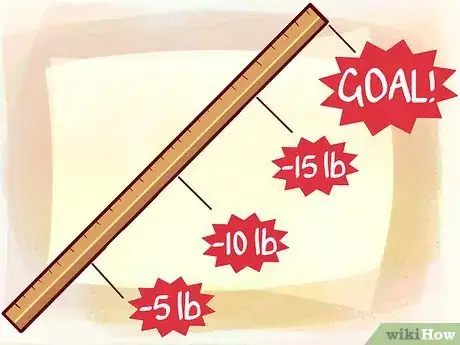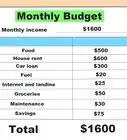This article was co-authored by Sydney Axelrod. Sydney Axelrod is a certified life coach and the owner of Sydney Axelrod LLC, a life coaching business focused on professional and personal development. Through one-on-one coaching, digital courses, and group workshops, Sydney works with clients to discover their purpose, navigate life transitions, and set and accomplish goals. Sydney has over 1,000 hours of relevant coaching certifications and holds a BBA in Marketing and Finance from Emory University.
There are 12 references cited in this article, which can be found at the bottom of the page.
wikiHow marks an article as reader-approved once it receives enough positive feedback. This article received 16 testimonials and 88% of readers who voted found it helpful, earning it our reader-approved status.
This article has been viewed 723,756 times.
SMART is an acronym that represents a framework for creating effective goals. It stands for five qualities your goals should have. They should be specific, measurable, achievable, relevant, and time-bound. The SMART method is one of the most popular and effective tools for creating realistic and achievable goals. You might be at the helm of a 300-person organization or you might be a small business entrepreneur. Or, you might be somebody who simply wants to shed 20 pounds. Regardless, learning how to set SMART goals can improve your chances of success.
Steps
Making your Goal Specific (S)
-
1Decide what you want. Your first step in any goal-setting framework must be to decide what it is you hope to achieve.[1] Try not to be to general and make sure that you are making the goal for yourself, not to impress someone else.
- Whether your goal is long-term or short term, most people start out with only a general idea of what they want. You move from the general to the specific by adding details and defining your terms.[2]
- For example, maybe your initial goal is be healthier. Knowing that will be your basis for creating a more specific goal.
-
2Get specific. "Specific" is the "S" in SMART. You have a much greater chance of accomplishing a specific goal than a general goal.[3] So, your task at this stage is to translate your thoughts from step one into something more precise.
- Following the example in the previous step, you would ask yourself what "healthier" means to you? What in your life needs to be better?[4]
- The goal has to be concrete and clear. Including numbers such as "I will go to the gym twice a week", can help. Nebulous and fluffy goals like "feel better" or "look better" are not easy to determine progress. Pick a goal that will be measurable. Examples:
- Lose or gain (x) amount of weight.
- Be able to run a 5K
- Cut sodium intake in my diet
Advertisement -
3Determine who is involved. A good way to make certain your goal is specific enough is to answer the 5 "W" questions: Who, What, When, Where, and Why. Start by asking who is involved.[5]
- Typically goals will center around you. But, some goals will require you to work with or for others.
- Example: Losing weight will naturally be you, but you may realize you need help of a nutritionist, a walking partner, and the support of your spouse to see it through.
-
4Ask what specifically you want to accomplish. This is the basic question of what goal you hope to achieve. It needs to be a concrete, specific goal that can be measured. [6]
- If you want to lose weight be specific! How much weight do you hope to lose? What is the smart amount? This means figuring out what is a healthy goal weight for you.
- Self-improvement goals like "gain confidence" is too fuzzy and broad, but something like, "Give the keynote speech at the conference", "ask out Chris to dinner", or "ride a subway" are all specific things that when accomplished will demonstrate self-confidence.[7]
-
5Determine where this will happen. Identify a location in which you will do the work of striving for your goal.[8]
- If you want to lose weight, you could exercise at work (going for a walk during lunch hour), at home (doing a home body weight workout or using weights), and at a gym.
- 'Where' can be physical or virtual such as on-line. For instance, it does not matter if you find a date by meeting prospective matches by first meeting them on-line or in real life.
-
6Think about when this will happen. Establish a realistic time frame or deadline for achieving your goal.[9] This will come more sharply into focus later in the process of goal setting. For now, just think about the big picture. Goals can always be extended if needed, but having a timeframe avoids having fuzzy and vague plans to do things.
- If your goal is to lose 20 pounds, you might be able to achieve that in a few months. On the other hand, if your goal is to get a degree in physics, a reasonable time frame for that might be a few years.
- In the example of achieving fitness, this may mean a reasonable time frame to lose weight, but also mean figuring out when you work out during the day, and considering how often.
-
7Identify which requirements and restraints as well as obstacles will be part of the process. In other words, what will you need to do to achieve your goal? What obstacles will you face?[10]
- If your goal is to lose weight, the requirements might be exercise and a healthy diet. The obstacles might include your own aversion to exercise. Recognize this, and consider how and why do you want to overcome that?
- Other obstacles: You may not have money for a gym, or a bad knee, or it is not a great neighborhood to walk outside at night. Consider how can these be worked around?
-
8Reflect on why you are setting this goal.[11] Jot down the specific reasons and benefits of accomplishing this goal. Understanding the "why" can be crucial to knowing if the goal you've set will actually meet your needs.[12]
- For example, imagine your goal is to lose 50 pounds. You hope to have more friends that way because you will feel better about yourself. But getting more friends has no direct correlation with weight loss. In that case, work on trying to be more outgoing, rather than on your appearance.
- But if losing 50 pounds will greatly benefit your health, and you know why, write the reasons down.
Making Your Goal Measurable (M)
-
1Create a "yardstick" for measuring outcomes. Your task now is to establish criteria for success. This will make it easy to track your progress and know when you have achieved your goal.[13]
- Your criteria can be quantitative (numbers based) or descriptive (based on describing a certain outcome).[14]
- When possible, put concrete numbers in your goals. This way you'll know without question if you're falling behind or if you're on track.
- For example, if your goal is to lose weight, you might make your goal quantitative by saying you want to lose 30 pounds. Knowing your existing weight, it will be easy to determine when you've met your goal. A descriptive version of this goal might be "I want to be able to put on a pair of jeans I wore five years ago." Either way, your goal is measurable.
-
2Ask yourself questions to sharpen your focus. There are a number of questions you can ask yourself to make sure your goal is as measurable as possible. These include:
- How much? For example, "how much weight do I hope to lose?"
- How many? For example, "how many times a week do I want to go to the gym?"
- How will I know when I've accomplished the goal?[15] Will it be when you step on a scale and see you've lost 30 pounds? Or 40?
-
3Track and measure your progress. Having measurable goals makes it easy to determine if you are making headway.
- For example, if your goal is to lose 20 pounds, and you've lost 18, you know you're almost there. On the other hand, if a month has passed and you've only lost a pound, this might signal that it's time to change your strategy.
- Keep a journal. This is a great way to keep track of the efforts you've made, the results you've seen, and your feelings about the process. Aim to write in it for about 15 minutes a day. This can help you keep things in perspective and can also release stress you might be feeling about your efforts.[16]
Making Sure the Goal is Attainable (A)
-
1Assess your limitations. You want to make sure that the goal you have set can actually be achieved.[17] Otherwise, you may become discouraged.
- Consider the restraints and obstacles you've identified and whether you'll be able to overcome them. To achieve any goal, you will face challenges. The question to consider here is whether it's reasonable to think you'll be able to accomplish the goal in the face of these challenges.
- Be realistic about the amount of time you have to devote to your goals as well as your personal background, knowledge, and any physical limitations. Think about your objective realistically, and if you do not think you can reasonably achieve it given your current life situation, set a new one that is attainable for you in the present.
- For example, imagine your goal is to lose some weight. If you can commit even a small amount of time to exercise each week and are willing to make some dietary changes, losing 20 pounds in 6 months is probably achievable. Losing 50 pounds might or might not be, especially if there are obstacles that could prevent you from exercising regularly.
- It's a good idea to write down all the foreseeable constraints you face as you make this assessment. This will help you develop a complete picture of the task you face.
-
2Assess your level of commitment. Even if a goal is theoretically achievable, you must be committed to making the efforts necessary to reach it. Ask yourself the following questions:
- Are you prepared to make the commitment to reach your target?
- Are you willing to dramatically alter or at least adjust aspects of your life?
- If not, is there a more achievable target you are willing to work for?
- Your goal and your commitment level should match up.[18] You might find it easier to commit to losing 20 pounds for starters, but 50 pounds might seem more overwhelming. Be honest with yourself about the changes you are willing to make.
-
3Set a goal you can achieve. Once you've considered the challenges you face and your level of commitment, adjust your goal as necessary.[19]
- If you decide your existing goal is achievable, you can move one to the next step. But, if you conclude that it's not really a reasonable goal, consider revising it. This doesn't mean you have to give up altogether. It just means adjusting your goal to fit your reality.
Making Your Goal Relevant (R)
-
1Reflect on your desires. Closely related to a goal's attainability is its relevance. This is the "R" in SMART. The question to ponder here is whether this goal will be fulfilling for you as individual.[20]
- This is a moment to revisit the "why" question. Ask yourself whether this goal will truly fulfill your desires or if there's a different goal that's more important to you.
- For example, imagine you are considering what you want to do after high school. You might be capable of getting your medical degree at a large, prestigious university. The goal is achievable for you. But, if your goal is to be a Broadway dancer, it does not matter what you could do. Getting into a pre-med program will hinder your dance career, and you would not succeed in the medical field, either.
-
2Consider your other goals and circumstances. It's also important to consider how your goal fits with other plans you have in life. Conflicting plans can create problems.
- In other words, its important to determine if your goal fits in with the rest of what is going on in your life.
- For example, imagine your goal is to go to an ivy league college. But, you also want to take over the family business in the next couple of years. Especially if the business isn't located near an ivy league college, this creates a conflict. You will need to reconsider one of both of these goals.
-
3Adjust your goal for relevance. If you decide your goal is relevant and will work well with your other plans, you can move on to the last step. If not, you'll need to make some more revisions.[21]
- When in doubt, go with what you're passionate about. A goal that you care deeply about will be both more relevant and achievable than one you're only sort of interested in. A goal that will fulfill your dreams will be much more motivating and worthwhile to you.
Making the Goal Time-Bound (T)
-
1Choose a time frame. This means your goal should have a deadline or there should be a date set for completion.[22]
- Setting a timeline for your goal helps you identify and stick to the specific actions that you need to take to work towards that goal. It removes the nebulous "sometime in the future" quality that goal setting sometimes encourages.[23]
- When you don't set a timeline, there is no internal pressure to accomplish the goal, so it can often end up on the back burner.
-
2Set benchmarks.[24] Especially if your goal is very long-term, it can be useful to break it up into smaller goals. This can help you measure your progress and make it manageable.[25]
- For example, if your goal is to lose 20 pounds in the next 5 months, you would set a benchmark goal of about one pound a week. This is less daunting and creates an incentive for consistent effort, rather than a big push to lose weight during the last couple of months. You can get an app that tracks your diet and exercise to make sure you're taking the necessary steps to reach your goal every day. And, if this turns out to be too much for you, you can go back and revise the goal to make it more achievable.
-
3Focus on the long term and the short term. Consistent progress toward your goals means keeping one eye on today and eye on the future. Within your established time frame, you might ask yourself:
- What can I do today to reach my goal? If the goal is to lose 20 pounds in five months, one daily goal might be getting 30 minutes of exercise every day. Another might be switching to healthy snacks like fruit and nuts, rather than potato chips.
- What can I do over the next 3 weeks to reach my goal? Here, the answer might involve creating a detailed meal plan or a workout schedule.
- What can I do over the long term to reach my goal? Here, your focus will be on keeping the weight off. Your focus will be on forming habits that promote a healthy diet and active lifestyle over the long term. You might consider, for example, joining a gym or sports team.
Expert Q&A
Did you know you can get expert answers for this article?
Unlock expert answers by supporting wikiHow
-
QuestionHow do I stay motivated to achieve my goals after a mistake?
 Sydney AxelrodSydney Axelrod is a certified life coach and the owner of Sydney Axelrod LLC, a life coaching business focused on professional and personal development. Through one-on-one coaching, digital courses, and group workshops, Sydney works with clients to discover their purpose, navigate life transitions, and set and accomplish goals. Sydney has over 1,000 hours of relevant coaching certifications and holds a BBA in Marketing and Finance from Emory University.
Sydney AxelrodSydney Axelrod is a certified life coach and the owner of Sydney Axelrod LLC, a life coaching business focused on professional and personal development. Through one-on-one coaching, digital courses, and group workshops, Sydney works with clients to discover their purpose, navigate life transitions, and set and accomplish goals. Sydney has over 1,000 hours of relevant coaching certifications and holds a BBA in Marketing and Finance from Emory University.
Certified Life Coach
-
QuestionHow can I track my success?
 Sydney AxelrodSydney Axelrod is a certified life coach and the owner of Sydney Axelrod LLC, a life coaching business focused on professional and personal development. Through one-on-one coaching, digital courses, and group workshops, Sydney works with clients to discover their purpose, navigate life transitions, and set and accomplish goals. Sydney has over 1,000 hours of relevant coaching certifications and holds a BBA in Marketing and Finance from Emory University.
Sydney AxelrodSydney Axelrod is a certified life coach and the owner of Sydney Axelrod LLC, a life coaching business focused on professional and personal development. Through one-on-one coaching, digital courses, and group workshops, Sydney works with clients to discover their purpose, navigate life transitions, and set and accomplish goals. Sydney has over 1,000 hours of relevant coaching certifications and holds a BBA in Marketing and Finance from Emory University.
Certified Life Coach You can measure your success by creating a benchmark of one to 10. For example, if your goal is to feel more at peace, rate how you feel at the beginning of the month on a scale from one to ten. After following through with your goal throughout the month, such as meditating a few minutes each day, compare how you feel at the end of the month based on that same benchmark.
You can measure your success by creating a benchmark of one to 10. For example, if your goal is to feel more at peace, rate how you feel at the beginning of the month on a scale from one to ten. After following through with your goal throughout the month, such as meditating a few minutes each day, compare how you feel at the end of the month based on that same benchmark. -
QuestionHow do I figure out my career goals?
 Meredith Walters, MBAMeredith Walters is a Certified Career Coach who helps people develop the skills they need to find meaningful, fulfilling work. Meredith has over eight years of career and life coaching experience, including conducting training at Emory University's Goizueta School of Business and the US Peace Corps. She is a former Member of the Board of Directors of ICF-Georgia. She earned her coaching credentials from New Ventures West and a Master of Business Administration from the University of San Francisco.
Meredith Walters, MBAMeredith Walters is a Certified Career Coach who helps people develop the skills they need to find meaningful, fulfilling work. Meredith has over eight years of career and life coaching experience, including conducting training at Emory University's Goizueta School of Business and the US Peace Corps. She is a former Member of the Board of Directors of ICF-Georgia. She earned her coaching credentials from New Ventures West and a Master of Business Administration from the University of San Francisco.
Certified Career Coach There are a number of things that can pull us off the right path. Choosing a path because it offers more power, money, or status can be very tempting, but if it doesn't align with other things that are meaningful to you, the excitement isn't going to last very long. To choose the right path, I recommend identifying the areas of life that you enjoy and are accomplished in. Think of what you are naturally good at and what skills you would like to develop further.
There are a number of things that can pull us off the right path. Choosing a path because it offers more power, money, or status can be very tempting, but if it doesn't align with other things that are meaningful to you, the excitement isn't going to last very long. To choose the right path, I recommend identifying the areas of life that you enjoy and are accomplished in. Think of what you are naturally good at and what skills you would like to develop further.
Warnings
- Don't make so many goals that it is impossible to prioritize them. You'll feel like you are not accomplishing anything, and you will likely feel overwhelmed. Do up to 1 big goal and about 1-2 small goals or 3 small goals.⧼thumbs_response⧽
References
- ↑ Sydney Axelrod. Certified Life Coach. Expert Interview. 30 June 2020.
- ↑ Fischhoff, B., Slovic, P., & Lichtenstein, S. (1988). Knowing what you want: Measuring labile values. Decision Making: Descriptive, Normative and Prescriptive Interactions, Cambridge University Press, Cambridge, 398-421. (Chapter 18)
- ↑ Morisano, D., Hirsh, J. B., Peterson, J. B., Pihl, R. O., & Shore, B. M. (2010). Setting, elaborating, and reflecting on personal goals improves academic performance. Journal of Applied Psychology, 95(2), 255.)
- ↑ Sydney Axelrod. Certified Life Coach. Expert Interview. 30 June 2020.
- ↑ https://www.ucop.edu/local-human-resources/_files/performance-appraisal/How%20to%20write%20SMART%20Goals%20v2.pdf
- ↑ https://www.ucop.edu/local-human-resources/_files/performance-appraisal/How%20to%20write%20SMART%20Goals%20v2.pdf
- ↑ Sydney Axelrod. Certified Life Coach. Expert Interview. 30 June 2020.
- ↑ https://www.ucop.edu/local-human-resources/_files/performance-appraisal/How%20to%20write%20SMART%20Goals%20v2.pdf
- ↑ https://www.ucop.edu/local-human-resources/_files/performance-appraisal/How%20to%20write%20SMART%20Goals%20v2.pdf
- ↑ https://www.ucop.edu/local-human-resources/_files/performance-appraisal/How%20to%20write%20SMART%20Goals%20v2.pdf
- ↑ https://www.ucop.edu/local-human-resources/_files/performance-appraisal/How%20to%20write%20SMART%20Goals%20v2.pdf
- ↑ Sydney Axelrod. Certified Life Coach. Expert Interview. 30 June 2020.
- ↑ Sydney Axelrod. Certified Life Coach. Expert Interview. 30 June 2020.
- ↑ http://www.goalsettingbasics.com/support-files/smart-instructions.pdf
- ↑ http://www.goalsettingbasics.com/support-files/smart-instructions.pdf
- ↑ http://psychcentral.com/lib/the-health-benefits-of-journaling/
- ↑ Lawlor, B. & Hornyak, M. (2012). SMART Goals: How the Application of Smart Goals can Contribute to Achievement of Student Learning Outcomes. Journal of Development of Business Simulation and Experimental Learning, 39, 259-267.https://journals.tdl.org/absel/index.php/absel/article/viewFile/90/86
- ↑ http://www.getorganizedwizard.com/blog/2009/02/smart-goals-5-steps-to-smart-goal-setting-with-free-goal-planner-template/
- ↑ https://www.careeronestop.org/ExploreCareers/Plan/set-goals.aspx
- ↑ Lawlor, B. & Hornyak, M. (2012). SMART Goals: How the Application of Smart Goals can Contribute to Achievement of Student Learning Outcomes. Journal of Development of Business Simulation and Experimental Learning, 39, 259-267.https://journals.tdl.org/absel/index.php/absel/article/viewFile/90/86
- ↑ https://www.careeronestop.org/ExploreCareers/Plan/set-goals.aspx
- ↑ https://www.careeronestop.org/ExploreCareers/Plan/set-goals.aspx
- ↑ http://www.goalsettingbasics.com/support-files/smart-instructions.pdf
- ↑ Sydney Axelrod. Certified Life Coach. Expert Interview. 30 June 2020.
- ↑ http://www.ascd.org/publications/educational-leadership/dec09/vol67/num04/When-Students-Track-Their-Progress.aspx
- ↑ http://www.appliedbehavioralstrategies.com/reinforcement-101.html
- ↑ https://theconversation.com/want-to-exercise-more-try-setting-an-open-goal-for-your-new-years-resolution-149172
About This Article
To set a SMART goal, start by choosing a goal that’s specific, measurable, attainable, relevant, and time-bound. For example, set a specific goal such as losing 20 pounds, and finding a way to keep track of your weight loss so that it’s measurable. Next, set realistic expectations, like losing 2 pounds a week, so that your goal is attainable. Then, make sure your goal is relevant, or fulfilling for you as an individual, rather than something you feel pressured to do. Finally, make the goal time-bound by setting a deadline for when you want to achieve your goal. For more advice, including how to identify and deal with obstacles that can keep you from achieving your goal, keep reading!



















































































